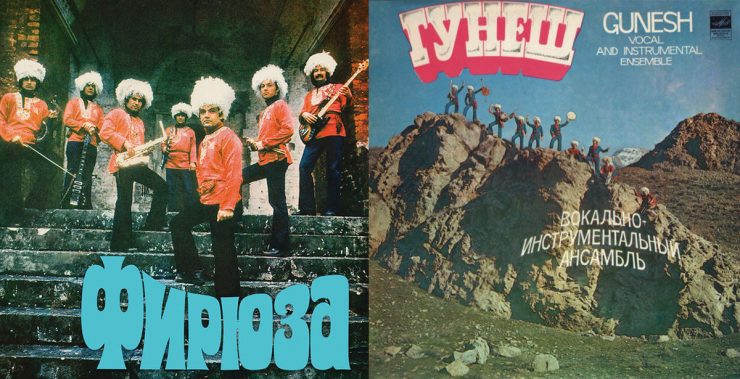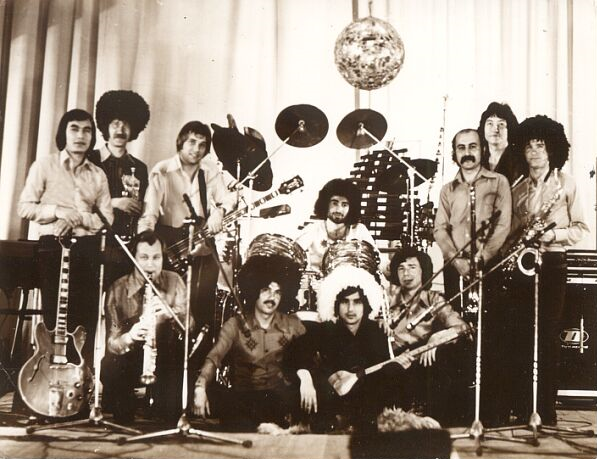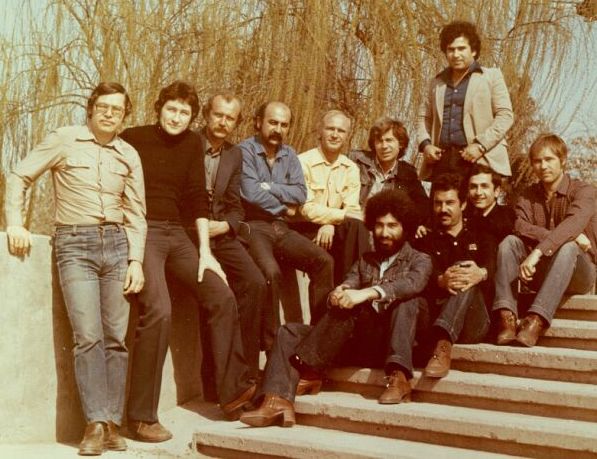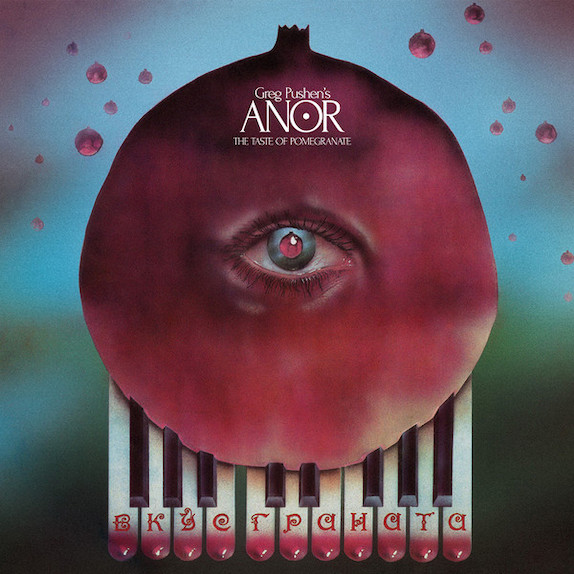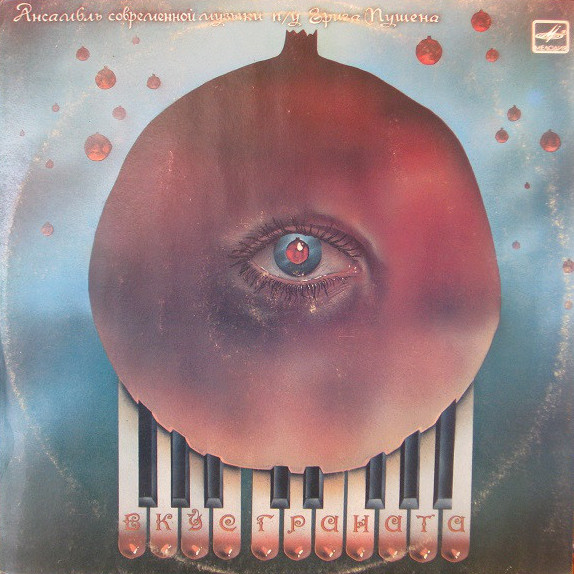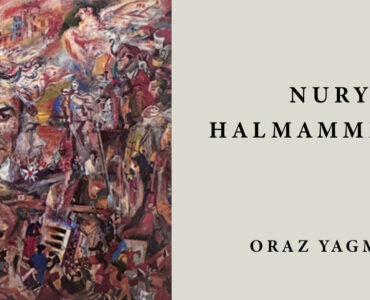This article was originally published in the EastEast magazine.
Hamdam Zakirov on the Turkmenian scene and the legacy of Fergana festival
In the third and final segment of Hamdam Zakirov’s series on Central Asian jazz, the Fergana-born poet and DJ chronicles noteworthy figures from the Turkmenistan scene of the late 70s and 80s and the era’s developments in technology and playing styles, concluding with some notes about the emergence of contemporary jazz scenes in the region and a surprising twist that has come in the form of re-releases of once forgotten LPs. For this last piece, Zakirov has also recorded a special mix (in both Russian and English, with special help with translation from his son Bruno), which is included below.
Little is known about the development of jazz in Soviet Tajikistan and Kyrgyzstan: as far as I can tell, no physical evidence in the form of any released records is available today. At the same time, the very history of jazz in Turkmenistan can be described as surprising and even as rather exciting.
In 1979, a record of the local instrumental band Firyuza was released. The group had been formed literally a year before by a few young members of the TV and Radio Variety Orchestra of the Turkmen SSR who wanted to perform their own music. At some point, they learned about the 6th All-Union Competition of Variety Artists in Leningrad, applied to join it, and after a while got an invitation. For five months, the band worked hard to prepare a rather complicated program and, having finally received permission to travel from their management, headed off to the northern capital in early February 1979. Unexpectedly, Firyuza was given 1st prize and became a laureate of the competition!
Certainly, the victory of Firyuza did not occur through sheer luck, but because of its members’ hard work on the compositions, graceful and intricate arrangements, and professional skills—logical, as bad musicians would hardly be able to perform with one of the main orchestras of the republic.
“Arranging each melody took a lot of time and effort. We worked at night, since during the day we were obviously busy at the orchestra’s rehearsals. In the end, we decided to pick up “Harmony” by Nury Halmammedov. This composition had a complex rhythm and became our trump card—in some ways we were innovators,” the band’s guitarist Mikhail Mammadov recalled years later.
As a laureate of the All-Union Competition, Firyuza was invited to make a record on the Melodiya label, and in 1979 their brilliant instrumental album was released, where Turkmen folk motives were mixed with jazz-rock—the only album the band eventually produced.
“Chapyksuar” by Firyuza
But the history of Firyuza, unfortunately, appeared to be too short. Its members managed to form a band, get ready for the competition, and win it, but surprisingly, local cultural officials showed no interest in them. Apparently, they did not fit into the usual music scene. Despite holding the title of the winners of the All-Union Competition, they were not given an opportunity to realize their potential in the style they had just so perfectly demonstrated. In protest, the participants left the pop orchestra where they were working and, lacking a base, the band virtually ceased to exist.
Things could have turned out completely differently! As a laureate of the All-Union Competition, the band was granted a set of musical equipment from the Dynacord company and was invited to join the music festival in Sopot, Poland. But the Turkmen Ministry of Culture declined all the offers saying that the band no longer existed. Moreover, Botir Zokirov, a popular Uzbek singer well-known around the USSR, offered the band the chance to move to Tashkent and promised to give them nine vacancies, that is, in fact, offered them jobs and an opportunity to create music. However, this also wasn’t meant to be: some musicians had families, others were studying, so moving to another city seemed like a decision too big to make at that point . . .
One can only guess what would have happened to Central Asian jazz if the collective then moved to Tashkent. But it did not occur, and Firyuza remained in the history of Soviet jazz as “the most famous band still unknown.” Apparently, neither Asian jazz lovers nor local musicians knew anything about them.
By the way, years later an interesting story took place regarding this Turkmen collective’s record. Since the group appeared and disappeared equally fast, never gave concerts and was pretty quickly almost forgotten, their label did not follow its usual strategy and never relaunched the record. Thus, by the early 2000s, the Firyuza LP had become virtually the rarest Soviet jazz record and international collectors are still ready to pay immense sums for that very first original pressing in good condition (the author of the article knows about one of them that sold for 1,499 Euro!). And, by the way, this is perhaps the only Soviet album that international pirates have already twice attempted to make illegal copies of! To release a vinyl record is technologically more difficult than a CD, so piracy is less common in this area of the music industry. Thus, it seems to be even more surprising that in recent years pirates have released the Firyuza LP twice—despite the fact that, as a part of the Soviet Grail series, there is an official legal reissue of very high quality.
Gunesh from Ashgabat is another Turkmen group worth mentioning. Unlike the instrumental music of the practically academic-sounding Firyuza which was characterized by their scrupulous, almost northern-like cold refinement of arrangements and performance, Gunesh is rather a traditional VIA, playing a mixture of pop music and folk motives, typical for other bands of this type, but doing this in a reckless and very daring way—feeling the groove, as one would say now. Progressive rock and jazz were among other motives to be discerned in their impressive vibe.
These Ashgabat guys got popular all around the Soviet Union back in the 1970s. Their age-old drive was something to be envious of. The Gunesh musicians became the laureates of international festivals in Poland (Zielona Gora, 1978), Bulgaria (The Golden Orpheus, 1979), the All-Union Competition “With a Song Throughout Life,” and the rock festival Spring Rhythms: Tbilisi-80, where Rashid Shafiev was awarded the title of the best USSR drummer. The band’s first record Gunesh was released in 1980.
“Zhigi-zhigi” by Gunesh
Four years later, Gunesh released another record: I See the Earth. To the surprise of many, it did not become, as has often happened, a poppier release. On the contrary, it sounded like a powerful and practically instrumental fusion album where one could spot almost hard rock elements!
I would like to finish our story with the latest jazz record released in Central Asia—The Taste of Pomegranate by a contemporary music ensemble directed by Grieg Pushen.
Grieg Pushen began his music career in the late 1960s. Back then his band Scythians was the most popular ensemble in Tashkent. In 1972, Pushen was invited to join a newly formed professional team, which was later named Yalla. He worked with them for ten years, making, among other things, arrangements for numerous popular compositions of this ensemble. In 1982, Grieg Pushen started working as a composer and arranger and launched his own recording studio.
A few years later a group was formed with which Pushen was going to make not popular music, as he had been doing before, but to search for an ideal combination of Uzbek folk music, jazz, rock, and fusion—something he certainly succeeded in, as evidenced by many great performances of Anor ensemble both in their native country and abroad. The Taste of Pomegranate, released in 1988 on the Melodiya label, presented the results of this search.
Records by Anor, 2019 and 1988
Donate to support Turkmen analysts, researchers and writers to produce factual, constructive and progressive content in their efforts to educate the public of Turkmenistan.
SUPPORT OUR WORK“The Eastern wave of Soviet jazz is now significantly influenced by the fusion style with its advanced electronics and synthesized sound worlds. Anor often uses the latest electronic equipment to give the sounds of regular string instruments and keyboards more folk colors. The synthesizer sounds like the Uzbek ney flute, while the guitar imitates the dutar, the sitar, or the tanbur. The soprano saxophone has the piercing sound of the zurna, which also gives the music a national flavor. The sound can be described as exotic and pretty unexpected—even for jazz,” the famous jazz critic Alexey Batashev commented on the record in his review.
So, if we do not take into account the somewhat isolated history of Turkmen jazz, almost the entire Central Asian wave of the 1970s-1980s was in one way or another connected with the Fergana Jazz Festivals. They greatly contributed to the development of jazz and became an incentive, a school, and a platform for both experiments and tests for musicians and bands. Individually, but somehow also collectively, the bands from this region created a unique mix of jazz, rock, and fusion with a rich local musical heritage not only from Central Asia, but from around the entire East. Of course, the music heritage of each group is in its own way unique, but decades later one can speak of all of them as a common phenomenon and a specific style.
And surely, one can fairly define Fergana as the jazz capital of Central Asia!
Around five to ten years later, already in literary circles Fergana was also glorified for its poets: the authors of the Fergana Poetic School are now well-known and translated into numerous languages around the world. However, this is a subject for a different article.
Without exception, all the records of the Central Asian bands mentioned in my text became collectible rarities twenty to thirty years later . Ten years ago, a new boom on vinyl records started generating interest in those unusual regional phenomena, which in their heyday had remained a purely local, marginal phenomena. The interest not only on the part of collectors, but also music lovers and enthusiasts searching for a new (albeit old in time) sound, led to the widespread appearance of the waves of so-called “grooves”: African grooves, Turkish grooves, Soviet grooves, and so on. Another trend had to do with various, already stylistically better-defined, “waves”: Ethiopian jazz, Bucovina klezmer, Habibi funk, Bollywood disco, and others.
“Yallama Yorim” by Anor
Musical archaeologists are interested in performers from the formerly remote parts of the world, in whose recordings ordinary jazz, funk, psychedelic, disco, synth, and rock acquire a brighter and better articulated ethnic national sound. Undoubtedly, in this regard, we could discuss the postcolonial dimension (as it seems to be fashionable now), as well as the globalization-related issues and deliberate exotisation that these releases bring up. But any attention to music (and I would like to talk only about music), as I see it, is never a bad thing either for it or for the musicians. What is more, the world’s interest in the “old” music of a particular region gives its contemporary performers a chance to be heard—which in the noisy polyphony of the 21st century is already a lot. Also, it provides an incentive to look up to the older colleagues, who, through their own works, started the tradition that can now be developed and built on.
At some point, the global wave of interest in the region’s peculiar sounds has also reached Central Asia. At present, the records of the bands I have briefly outlined in this article, are valuable pearls in the collections of the seekers of vinyl treasures around the world. And yet, some three to four years ago I would have never come up with a guess that this interest in the Central Asian wave might end up in these records being relaunched. But this is what has actually happened!
In 2017, Soviet Grail—a branch of the Russian music company ZBS Records—made themselves known with the release of Efsane record by Sato, a Fergana band. Both Sato albums, Firyuza and I See the Earth by Gunesh, Anor by Grieg Pushen, and the first album of the Kazakh group Dos-Mukasan have already been re-released. A full discography of the Almaty group Boomerang, Eastern Suite by Oleg Gotskozik’s quintet, and other records are being prepared for reissue as well—each of them with a big story of their own.
And now I can call it a day—but not in a way I was initially planning. I was going to finish this article with an existential sounding sad phrase, something like “It was a wonderful era, but, alas, it is over,” implying that once the music was better and the grass was greener. “OK, boomer!”, the reader would say and close the page. But my new ending is going to be completely different.
While working on these articles, I talked with Leonid Atabekov (from Sato) and other musicians and collectors, contacted Ferghana residents who had attended festivals, and asked a few questions to Sergey Klimov (the founder fo Soviet Grail). And suddenly the puzzle came together: some recordings of the festival performances were found! They were not enough to make a separate concert disc of any particular band, thus they did not attract the attention of recording studios. But all of us agreed that the idea to release a compilation of the Fergana Jazz Festival was brilliant! Together with Leonid Atabekov we decided to write a more complete history of these festivals for the release of this record.
Certainly, now it is just an idea. But we are really longing to put it into life and most importantly—we already have these very records we have come across by pure chance. A lot of meticulous work still needs to be done for CD and vinyl copies to appear, including the restoration of the records. Also, it would be great if we managed to find sponsors. Who knows, maybe we will be able to meet them among EastEast readers!
Mix by Hamdam Zakirov and his son Bruno recorded specially for EastEast. You may find the tracklist on our Soundcloud.
Still, I would not like to end with, albeit such an inspiring, but still retrospective piece of news. Unfortunately, I do not know so many contemporary performers from Central Asiabut I will mention a few:
I would like to start with the Turkmen group Ashkhabad whose music I partly see as the heritage of the group Gunesh, but working in the genre of folk. In 1993, on Real World—a prestigious label founded by Peter Gabriel—they released the album City of Love, immediately becoming one of the top “world music” bands. In 2009, with the death of their vocalist Atabai Charykuliev, Ashkhabad ceased to exist, but their records certainly deserve attention. Speaking about musicians from Kazakhstan, I would like to mention at least Damir Uisumbayev (part of the projects Nar and DAMU), who works at the intersection of jazz, folk, and rock. Uzbekistan quite deservedly can be represented by the Tashkent ensemble DalaHast. And although their style is closer to ethno-soul and all the same “world music,” a strong jazz school can undoubtedly be felt in the performing manner of both the musicians and the singer. It seems they really have a big potential.
The second part of Hamdam Zakirov’s notes on Central Asian jazz can be found here
Translated from Russian by Olga Bubich
CONTRIBUTORS
Poet and record collector, living in Helsinki. He is one of the authors belonging to the renowned Ferghana school of poetry, whose poems have been translated into more than a dozen languages. Hamdam has been performing as a DJ and taking part in various events and festivals in Finland, Estonia, Latvia, Germany, and Israel since 2016. He records mixes that feature Soviet grooves and hosts a podcast dedicated to popular Uzbek music.

